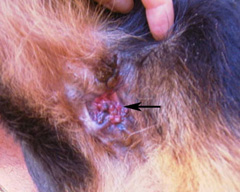Perianal fistulas are tunnel-like formations in the skin and deeper tissues that surround the anal area of dogs. The lesions vary in severity but at first appear as small oozing holes in the skin. These holes may become wide and deep and surround the entire circumference of the anus. Although this condition can occur in any dog, German shepherds are most commonly affected. Position of their tail, which is often carried low between the hip bones, covering the anus, is thought to be a predisposing factor. Perianal fistulas may cause severe pain and discomfort and, if not controlled, may be responsible for a dramatic reduction in quality of life. Affected dogs may have concurrent chronic diarrhea because of inflammatory bowel disease; in fact, the two conditions may be related. This disease shows many similarities to Crohn’s disease in people.
Your pet may show signs of:
- painful defecations
- straining to defecate
- constipation
- diarrhea
- mucus or blood in stools
- excessive licking and biting of the anus
Chronic pain in the affected area may make your pet restless and to cry every time they are about to defecate. Some affected dogs will struggle or try to bite when their tails are lifted.
A complete physical examination must include digital rectal examination, since infection or obstruction of the anal sacs can also cause perianal fistulas (Figures 1 and 2). Your pet may need to be sedated if painful. Cell or tissue samples from the anal sacs or fistula may be collected for microscopic examination (aspiration cytology or histopathology) or for bacterial culture and sensitivity.


Since the condition recurs in as many as 80% of dogs (depending on the treatment), medical and surgical treatments are usually combined in order to improve the long-term results. The medical treatment is in many instances performed by a board-certified veterinary dermatologist or internist.
Strategies for the medical treatment include:
- a change in diet to a novel protein diet
- antibiotics such as metronidazole
- oral anti-inflammatory/immunosuppressive drugs, such as prednisone, cyclosporine, and azathioprine
- topical immunosuppressive drugs, such as Tacrolimus
Surgical treatment is usually performed in the following situations:
- when lesions are small,
- to remove affected anal sacs,
- if fistulas don’t heal completely after medical treatment, or
- to make dogs more comfortable in severe or recurrent cases.
Surgical treatment may be used to remove necrotic (dead) tissue associated with the fistulous tracts and help promote healing. Cryosurgery and laser are commonly employed. During cryosurgery the diseased tissues are frozen with a special probe (Figures 3 and 4). These tissues die and eventually slough, allowing healing to occur. Freezing the tissues may make your dog feel less pain immediately after surgery. Lasers can be used to kill the lining of the fistulas; like freezing, the damaged tissues die and the area gradually heals.


Another surgical technique employed in selected cases is the amputation of the tail. Removal of the tail may allow better aeration and cleaning of the area, which will facilitate the healing of existing fistulas and also help decrease the recurrence rate.
Dogs that have cryosurgery or laser surgery will have open raw wounds for several weeks that will require daily gentle cleaning to remove dead tissue, bacteria, and fecal material from the area. Laxatives (stool softeners) such as lactulose may be added to the treatment, especially in dogs with severe pain during defecation. Some of these pets will need to wear an e-collar at all times in order to prevent self-mutilation.
Unfortunately, perianal fistulas may require lifelong medical management with special diets and drugs that suppress the immune system. These drugs can have serious side effects and should never be combined with any other medications (including those for arthritis) unless approved by your primary care veterinarian. Prognosis for initial healing early lesions is good; however, recurrence is common, particularly in dogs with moderate to severe disease. Chronic damage to the perineal region by perianal fistulas or after multiple surgeries may affect the nerve supply to the area, leading to fecal incontinence (when animals are not able to control when/where to defecate).
Effective preventive measures are not known. High quality diets may decrease the chance of inflammatory and allergic intestinal diseases, which are often associated with perianal fistulas. Since German shepherds are at an increased risk for the disease, heredity may play some role in their development; thus, dogs with perianal fistulas should not be bred.












